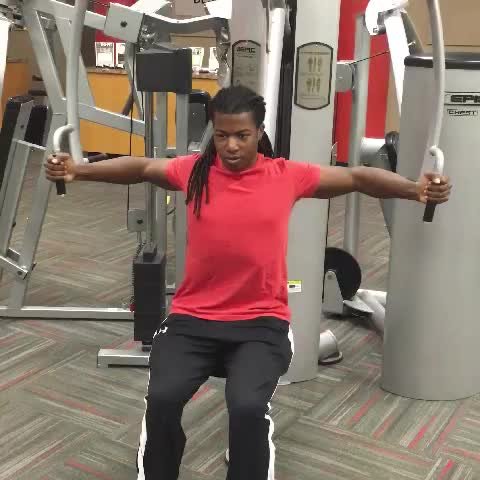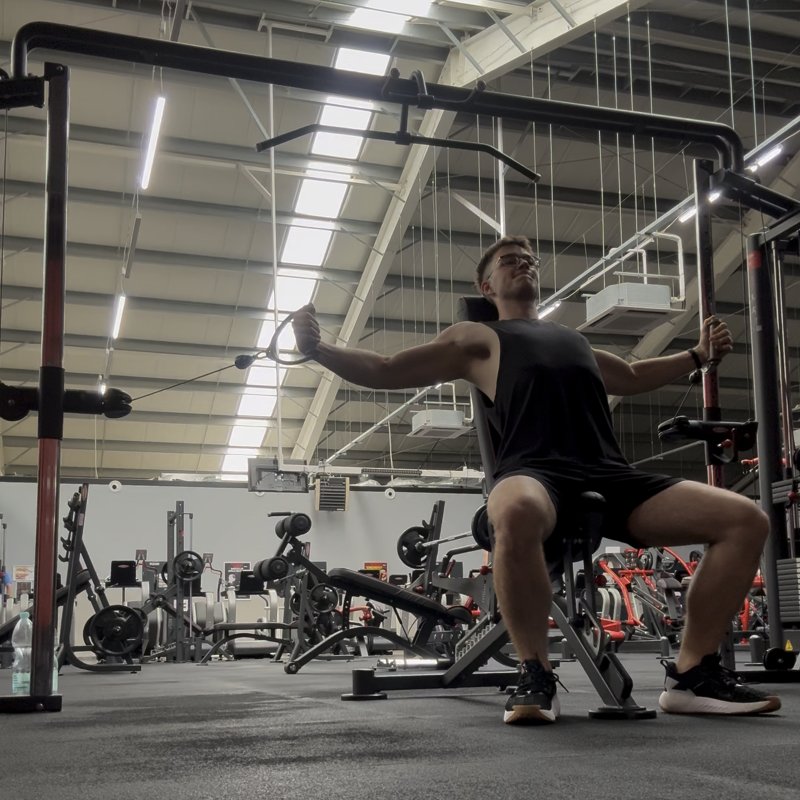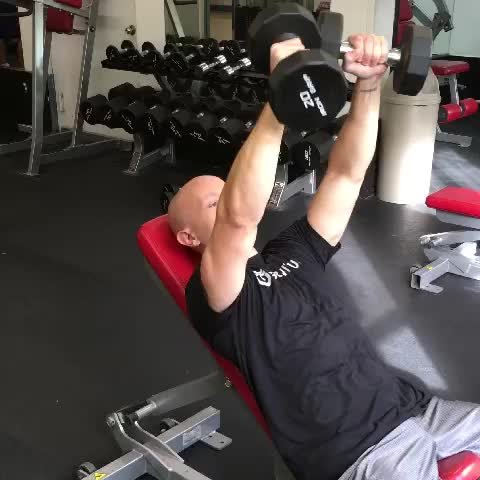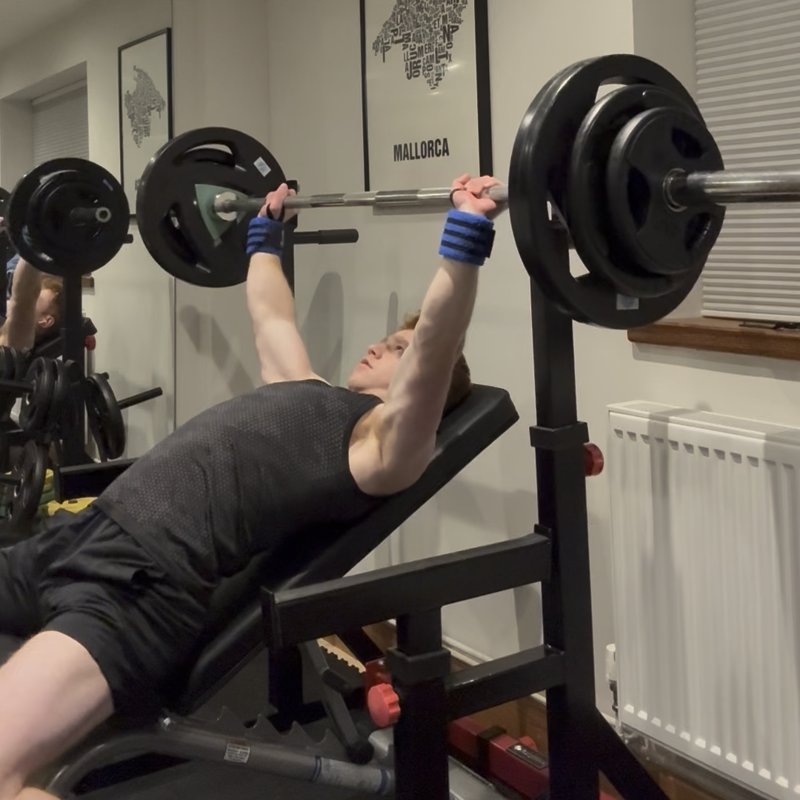Machine Fly: The Ultimate Guide
The machine fly is an effective isolation exercise that targets the pectoral muscles while providing stability and controlled resistance. This guide covers proper technique, common mistakes, and programming strategies for optimal chest development.

Quick Facts
Key Benefit
Directly targets the chest muscles with constant tension and reduced shoulder stress
Primary Muscles
Pectoralis Major
Secondary Muscles
Anterior Deltoids, Biceps, Pectoralis Minor
Equipment
Machine
Difficulty
Beginner
Type
Isolation, Hypertrophy
In This Guide
Ready to master the Machine Fly?
Track your progress, see improvements over time, and build strength consistently.
Download GravitusThe Machine Fly is an excellent isolation exercise for targeting the pectoral muscles. Using a fixed movement path and supportive design, this machine-based exercise allows you to focus intently on chest activation while minimizing the stability requirements and joint stress that can occur with free-weight alternatives. Also known as the "pec deck" or "chest fly machine," this exercise creates constant tension throughout the range of motion, providing an effective stimulus for muscle growth and development. The horizontal adduction movement (bringing the arms inward across the body) specifically targets the pectoralis major, with additional engagement of the anterior deltoids and serratus anterior. The machine fly is particularly valuable for beginners learning the chest adduction movement pattern, those rehabilitating from injuries, and experienced lifters seeking additional chest volume with reduced joint stress. It can be effectively incorporated as a complement to compound pressing movements in a chest-focused workout or used as a pre-exhaust technique before heavier pressing exercises. This comprehensive guide covers proper machine fly technique, common mistakes to avoid, effective variations, and programming strategies to help you maximize your chest development with this versatile exercise.
Why the Machine Fly Is Worth Mastering
The machine fly offers several distinct advantages that make it a valuable addition to your chest training arsenal:
Targeted Chest Isolation
Provides direct stimulation to the pectoral muscles with minimal involvement from other muscle groups, allowing for focused chest development.
Constant Tension
Maintains consistent resistance throughout the entire range of motion, creating an effective stimulus for muscle growth with both concentric and eccentric phases.
Reduced Joint Stress
The fixed movement path and supportive design decrease strain on the shoulder joints compared to dumbbell flyes, making it accessible for those with certain shoulder limitations.
Proper Machine Fly Form: Step-by-Step
Setup
- Adjust the seat height so that the movement arms align with your mid-chest level (around nipple height for men).
- Set an appropriate weight that allows for controlled movement with proper form.
- Sit facing the machine with your back flat against the pad and feet firmly planted on the floor.
- Grasp the handles or place your forearms against the pads (depending on machine design).
- For forearm pad designs, position your elbows at approximately 90 degrees; for handle designs, maintain a slight bend in the elbows.
- Sit tall with chest up, shoulders back and down, and core engaged.
The Movement
- With proper posture established, exhale as you bring the movement arms together in a controlled, smooth motion.
- Focus on using your chest muscles to perform the movement, thinking about hugging a tree or squeezing a ball between your hands.
- Continue the inward movement until the pads or handles are in front of your chest (they may not touch, depending on the machine design).
- At the peak contraction, focus on squeezing your chest muscles for 1-2 seconds.
- Inhale as you slowly return to the starting position with control, maintaining tension in the chest muscles.
- Stop just before the weight stack touches down, keeping tension on the chest muscles throughout the set.
- Repeat for the desired number of repetitions, maintaining proper posture and controlled movement.
Key Form Tips
Chest Engagement
Focus on leading the movement with your chest muscles, not your shoulders or arms.
Elbow Position
Keep elbows at chest height throughout the movement; don't let them rise toward your shoulders.
Range of Motion
Find a range that allows maximum chest contraction while avoiding extreme stretching that could stress the shoulders.
Controlled Tempo
Use a deliberate pace, especially on the eccentric (return) phase, aiming for 2-3 seconds on the way back.
Posture
Maintain a tall spine with shoulders back and down, avoiding the tendency to hunch forward.
Breathing
Exhale during the exertion (bringing arms together), inhale during the return phase.
Muscles Worked in the Machine Fly
Primary Muscles
- pectoralis major: The large, fan-shaped muscle of the chest is the primary target, particularly the sternal (mid and lower) portion during this horizontal adduction movement.
Secondary Muscles
- anterior deltoids: The front portion of the shoulder muscles assist in the horizontal adduction movement, especially as the arms move forward.
- serratus anterior: Located along the side of the ribcage, these muscles assist in stabilizing the scapula during the movement.
- biceps: Act as secondary stabilizers during the movement, particularly when using handle-grip machines.
- pectoralis minor: A smaller chest muscle that lies underneath the pectoralis major and assists in scapular movement during the exercise.
Common Mistakes and How to Avoid Them
Using excessive weight
Going too heavy typically leads to reduced range of motion, shoulder recruitment, and possible injury. Select a weight that allows full control of the movement while feeling tension in the chest throughout the entire range of motion. You should be able to perform the movement smoothly without jerking or using momentum.
Hunching forward
Leaning or rounding the shoulders forward shifts emphasis away from the chest and can strain the neck and upper back. Maintain proper posture with your back against the pad, chest up, and shoulders pulled back and down throughout the entire set.
Flaring elbows too high
Positioning the elbows above shoulder height increases strain on the shoulder joints and reduces chest activation. Keep your elbows at chest height throughout the movement, in line with the middle portion of your pectorals.
Bouncing at the end ranges
Using momentum by bouncing at either the stretched position or the contracted position reduces muscle tension and increases injury risk. Control the movement throughout the entire range of motion, especially at the transition points, and consider pausing briefly at the point of peak contraction.
Machine Fly Variations
Machine Variations
-

Pec Deck Fly
Uses padded levers that contact the forearms, allowing for focused chest contraction with reduced grip requirements.
-
Cable Fly Machine
Utilizes a dual pulley system with handles, providing more freedom of movement while maintaining the benefits of constant tension.
-

pectoralis major
Features weight-loaded lever arms that move through a fixed path, often offering slightly different movement mechanics than traditional pec deck machines.
Execution Variations
-

Single-Arm Machine Fly
Performing the movement one arm at a time increases core engagement and allows for greater focus on each side independently.
-

Pulse Reps
Using short, partial-range pulses at the point of peak contraction to increase time under tension and metabolic stress.
-

Eccentric-Focused Machine Fly
Emphasizing the negative (return) phase by taking 4-5 seconds on the eccentric portion of each repetition, often using a weight slightly heavier than normal.
FAQs About the Machine Fly
Both exercises target the chest through a similar horizontal adduction movement, but with notable differences. Machine flyes provide a fixed movement path, constant tension throughout the range of motion, and reduced stabilization requirements, making them generally easier to learn and less stressful on the shoulder joints. Dumbbell flyes require more stabilization, allow for greater range of motion customization, and engage more auxiliary muscles. Machine flyes are often better for beginners, those with certain shoulder issues, or anyone looking to isolate the chest with reduced joint stress. For optimal development, consider incorporating both variations in your training program when possible.
The optimal sequencing depends on your specific goals. For general strength and muscle building, performing machine flyes after compound pressing movements (like bench press) is typically recommended, as it allows you to devote maximum energy to the heavier compound lifts that build overall strength. However, using machine flyes as a pre-exhaust technique before pressing can be valuable for emphasizing chest activation and recruitment during those subsequent compound movements. This approach can be particularly effective if you tend to feel pressing exercises more in your shoulders or triceps than your chest. Experiment with both approaches to determine what works best for your specific goals and body mechanics.
While machine flyes are an excellent isolation exercise for the chest, they generally shouldn't completely replace compound pressing movements like bench press for most trainees. Compound exercises engage more total musculature, allow for heavier loading, and promote greater hormonal response and overall strength development. The ideal approach for most people is to include both movement types—compound presses for overall strength and mass, complemented by isolation movements like machine flyes for targeted chest development. That said, machine flyes can temporarily replace pressing movements during rehabilitation periods or for trainees with specific limitations that make pressing movements problematic.
Video Demonstrations

Log in to watch video demonstrations
Login to Watch3 video demonstrations available
Find more video demonstrations in the Gravitus app
Tips from the Community
-

Keep your elbows up throughout the entire movement.
-

Nie walcie jak łączycie ręce to pompa w chuj
-

ciągnij jakbyś miał złączyć łokcie nie nadgarstki
Track your progress with Gravitus
Download Gravitus to log your workouts, track your progress, and join a community of fitness enthusiasts.

Helpful Resources
One Rep Max Calculator
Find your one rep max for any exercise without maximal testing. Essential for developing effective strength training programs.
Calculate 1RMWorkout Programs
Follow structured workout programs created by fitness professionals to maximize your strength and muscle gains.
View Programs




